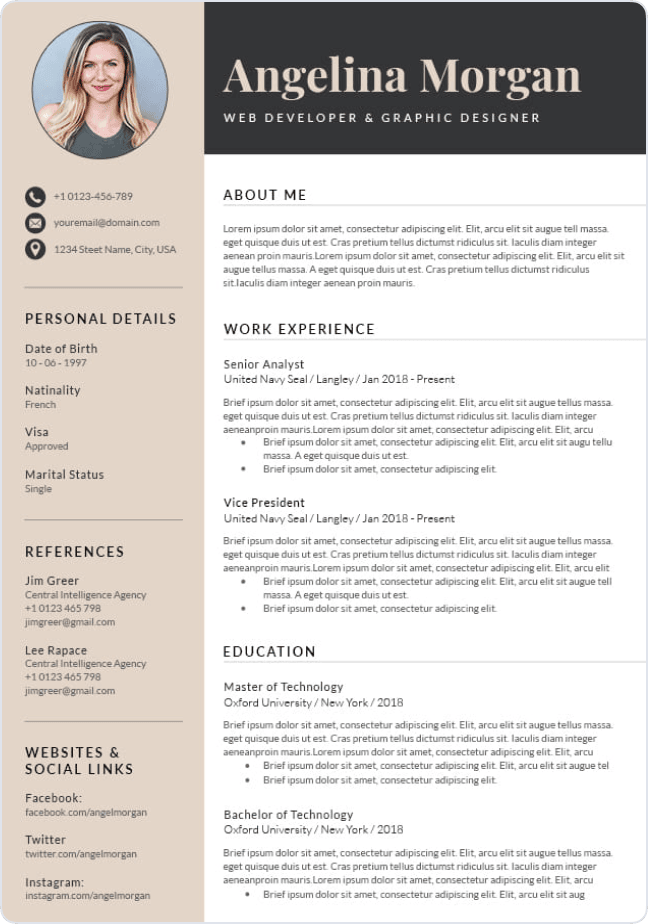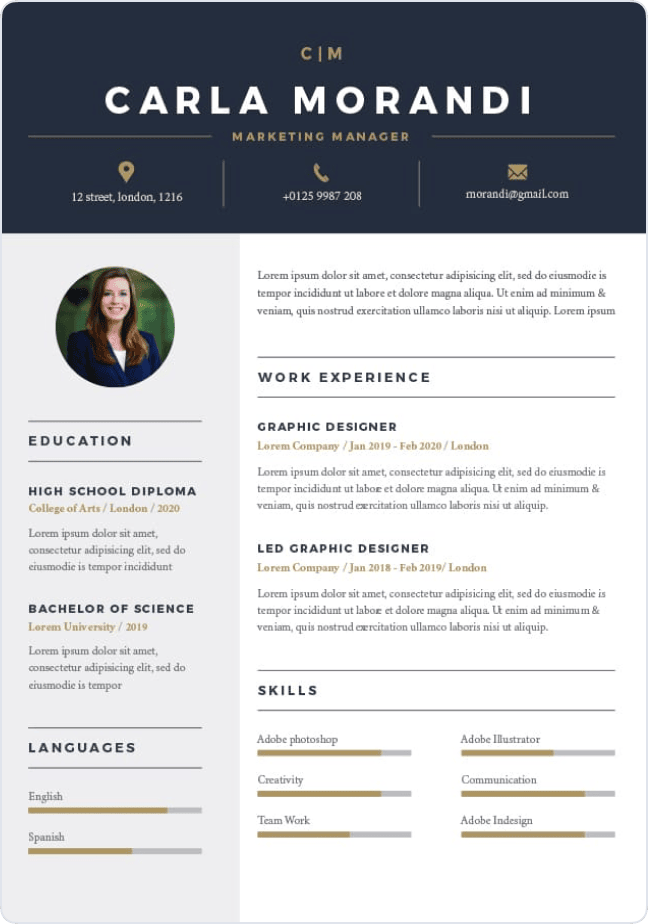An ophthalmic technician works as a medical assistant to an ophthalmologist, commonly known as the eye doctor while providing patient care through clinical tasks. These tasks include, but are not limited to, writing a medical record with patient history, giving instruction on tests, procedures, and medications, and conducting diagnostic tests.
The ophthalmic technician works closely with a physician. It’s not just simply fitting contact lenses. Their assistance allows the ophthalmologist to cater to more patients daily. They assist physicians during the conduct of surgical procedures, prepare patients for clinical trials, and more.
The tasks are already exciting, but the average pay of around $37,940 a year makes it even more enticing. According to US News, the best-paid ophthalmic technicians could make up to $47,490 a year. But to nail an ophthalmic technician job at your dream clinic, you must prepare a professional resume.
Not enough time? You can also browse our ophthalmic technician resume examples to get ideas on what to include. Or better yet, you can use our ophthalmic technician resume template to save time and effort.
But if you're learning how to write an ophthalmic technician resume, we'll help you! And in no time, you'll be able to score an interview and get the job.
Crafting a Stellar Ophthalmic Technician Resume
You may have all the needed skills and experiences to be the best candidate as an ophthalmic technician, but how will you land a job without a professional resume?
Your ophthalmic technician resume should convince hiring managers that you’re the best fit for the job. To do that, you must highlight relevant skills and experiences that are valuable to the position you’re applying for. Let’s take a step back and recall the basics of creating a resume.
The standard contents of an ophthalmic technician's resume are the following:
- Header
- Professional Summary
- Work Experience
- Skills
- Education
Additional sections may be added if you think they’ll further support your experiences and skills. As with any technician resume, certifications and training hold significant value. Some companies even include these in the qualifications stated.

Perfecting an Organized Layout and Format
This is the most important section of writing your ophthalmic technician resume. The goal is to catch the reader's attention. Remember that hiring managers only take a few seconds to decide whether your resume is worth reading or not.
A standard resume is only one page long. It's only acceptable to add another if your skills and experiences don't fit in one. The margins are typically an inch on all sides. It should also be aligned on the left, not centered.
Maintain a clean-looking resume by keeping it plain and simple. Be consistent with your chosen font, which should be easy to the eyes. You could choose Arial, Calibri, Times New Roman, or Verdana. Font sizes can be used to emphasize sections and important information.
There are three types of resume formats that you can choose from in making your technician resume:
This format is best to use if you want to emphasize your career progression as an ophthalmic technician. For example, you started first as an ophthalmic assistant and moved to become a certified ophthalmic technician. This format lists the latest or recent work experience on top and ends it with the first job.
The functional resume format emphasizes your ophthalmic technician skills rather than your career experience. This is highly suggested for those ophthalmic technicians with gap years in their professional history. This way, the hiring managers will focus on the skills they can bring to the table. A technician's resume is mostly written this way since it's a skill-focused job.
This type of resume mixes both the chronological and functional formats. In writing a hybrid resume, your skills and achievements go first, followed by your professional history as an ophthalmic technician.
A Remarkable Header
The header of your technician resume is the first thing the hiring manager will see. It’s located at the topmost portion of your resume. It should include your complete name and all the necessary contact information. This is crucial because this is how the hiring manager will reach you.
Here’s an example of a well-written header 👇🏼
#3, Street Name, New York City, USA
(987)654-321 | johndoe@email.com
As seen in the sample above, your name and title are emphasized. It should include your complete home address, correct contact number, and a formal email address. Take note that your email should also be professional-looking. It could be made from your complete name or initials.
Meanwhile, here’s an example of a bad header 👇🏼
 INCORRECT
INCORRECTNYC, USA
jdontherocks@gmail.comThere are multiple concerns in the header above. First, it doesn't include the current job position. Second, it doesn't state the complete home address. Third, the contact number isn't stated; how will the hiring manager contact you? Lastly, the email address is unprofessional. This is a major red flag.
Photos are always optional unless the company specifically requires them. But if you would like to include one, wear formal attire. The background should be in solid color, most preferably white. It should be taken in high quality. Remember to be professional in your photo; no wacky faces or peace signs are allowed.

Highlight Your Work Experience
An ophthalmic technician is a highly skilled allied health personnel who works in the field of eye care. Be careful not to confuse it with an ophthalmic assistant, who generally has fewer duties than a technician. You can work in outpatient care centers, hospitals, private practices, and surgical centers.
Being an ophthalmic technician requires strong knowledge of using different ophthalmic equipment. It also helps if you’ve experienced how to update electronic medical records, obtain ocular history, regulate patient flow, and conduct preliminary screening examinations and ophthalmic testing.
But besides the technical experience you have, don’t forget to include the basic patient care duties you’ve done. This is important because you’re dealing with multiple patients a day. Detailing this will further prove your point as a worthy candidate for the job.
Write your work experiences in bullet form to make them readable and easy to the eyes. Indicate the name of the institution you’ve worked for and the included years. Keep it detailed but brief. You’re not just being judged as an ophthalmic technician but also as a communicator.
Ophthalmic Technician Example
This section will show you good and bad examples of demonstrating your ophthalmic technician experience.
Let’s first see an example of a poorly written work experience 👇🏼
 INCORRECT
INCORRECTFlorida State Hospital, 2019-2021
- Provided patient care by performing eye-related clinical tasks
- Assisted appropriate physician in a minor office surgery
- Supervised certified ophthalmic assistant
- Instructed patients to use contact lenses properly
- Conducted visual field testing
- Recorded medical histories of patients
The example above isn’t wrong, by definition. However, it’s very generic and vague. Writing your experiences like this won’t make you shine in the eyes of a hiring manager. Although being an ophthalmic technician is a unique career, your few competitors also have similar experiences to you.
To stand out, you need to be really specific. It's important to use strong verbs to describe your experiences and specify which procedures you've done.
Let’s now see a good example of work experiences 👇🏼
Eye Specialist Clinic, 2020-2022
- Assisted surgeon in ophthalmic surgical procedures, such as cataract surgery
- Interviewed patients about their medical history and used it to provide the needed patient care
- Recorded the patients’ blood pressure measurement, potential acuity meter, peripheral visual field tests
- Updated the patients’ medical records regularly with precision and accuracy for the convenience of the physicians
- Gave clear instructions to patients about the proper use of contact lenses based on patients’ visual acuity
Observe the difference between the two examples given. The latter example is evidently more powerful than the former one. It shows confidence that you are well-experienced in the field, making you more valuable to the hiring company.

Educational History
A career as an ophthalmic technician doesn't require a bachelor's degree. So if you're interested in the healthcare industry but don't want to take up medical school, this is a perfect choice. However, it's still important to include any educational experience you had.
Although, you must note that even though it's not required, some companies might prefer to hire someone with a degree. You must review the job qualifications and descriptions the company states in its hiring announcement.
This section is pretty simple. You must include the name of the school where you graduated, its address, and years of duration. If you have any awards or distinctions, feel free to include them. Your general weighted average (GWA) isn't necessary, but if you think it'll help your case, you may also include it.
Here’s an example 👇🏼
Florida National High School, Florida
With Distinction
2013-2017
Showing Off Your Ophthalmic Technician Skills
As you've read in the previous section, a degree isn't needed in this profession. With that, it's truly a battle based on experiences and skills. Now, you can easily search for skills to include, and the result might show generic examples only. In pursuing a skill-driven career, you must write highly relevant skills. It also helps if you align them to the description included in the job vacancy post.
Generic Skills
The generic soft skills are important, especially for an ophthalmic technician. Daily, you'll be dealing with external (patients) and internal customers (doctors, surgeons, etc.). You must know how to deal and work with them, respectively.
For an ophthalmic technician, here’s a list of soft skills you must include in your technician resume 👇🏼
- Excellent customer service
- Organizing skills
- Problem-solving skills
- Analytical skills
- Conflict management
- Teamwork
- Detail-orientation
- Basic understanding of Microsoft Office 2010
- Stress management
Technical and Specialized Skills
Being an ophthalmic technician requires a lot of technical skills. You need to include important specialization skills to indicate your expertise in the field of ophthalmology. You hold a significant role in being able to provide needed patient care to your clients and give assistance to your assigned physician.
Here are some examples of specialized skills that must be included in your technical resume 👇🏼
- Patient care skills
- Visual acuity
- Ocular motility
- Intraocular pressure
- Visual field testing
- Diagnostic testing
- Usage and administration of contact lens

Writing an Impressive Professional Summary
A professional summary is a run-through of your strengths and objectives as an ophthalmic technician. It should be brief and catchy since it'll be seen in the second section of your technician resume, just right after the header. This should summarize your career: skills, experiences, and achievements.
It'll be difficult to squeeze everything into just a few sentences. A pro-tip would be to skip this part first and then go back to it once you've finished the rest of your resume. You'll be able to pick out the skills and experiences you want to specifically include in your summary.
Take note that you must align your summary with the rest of your resume. Don't create some made-up story that indicates inconsistency. The hiring manager will surely notice this, and it could be a way for you to lose a good job opportunity.
To better illustrate, here’s an example of a well-written professional summary:
As seen in the example above, it's concise and direct to the point. It doesn't confuse the reader and gives off a sense of professionalism with the words used and the formation of the paragraph. If you also have achievements, include them using quantitative words or phrases.
Meanwhile, here’s a look at a badly written summary:
 INCORRECT
INCORRECTAdditional Sections for your Resume
If you have more qualifications to help you secure the job position, you may add more sections. One example is to include certifications as a section.
Certifications
There are three levels of expertise in the ophthalmology field. The entry-level for this field is a certified ophthalmic assistant (COA). This level primarily focuses on administrative tasks and not much on the technical side.
You're aiming for the certified ophthalmic technician (COT) position. This is the second level in the field. COTs also perform similar tasks to the COA but are more exposed to the technical procedures and testing. At this level, you will be able to explain results to patients and conduct basic examinations alone.
The last and top-level is the certified ophthalmic medical technician (COMT). COMTs are allowed to perform complex operations and examinations. This certification allows the COMT to supervise COTs and COAs.
If you already have these certifications, it'll give you a one-up against competitors who aren't certified. Be sure to include the name of the institution where you got the certification and the year you received it.
Languages
Languages is an optional section. However, you should add this section if the qualifications state a certain language. This also applies to foreigners whose nationality doesn't have English as their national language.
In healthcare, it's possible to have patients from other parts of the world who speak different dialects. For this reason, the hiring company might prefer you if you speak multiple languages.
Boosting Your Ophthalmic Technician Resume
We’re done with the step-by-step process of creating your technician resume. It’s time for you to learn how to improve it with the following tips and tricks:
- Be brief. Don't beat around the bush; you must be direct in showing your value as the best candidate for the ophthalmic technician position.
- Double-check. Misspellings and incorrect grammar are huge turn-offs for hiring managers. Ensure that your contact information is updated and accurate.
- Keep it short. Follow the one-page rule and avoid adding irrelevant information or big words.
- Modify your resume and make it specifically tailored to the specifications of the ophthalmic technician position and any other additional qualifications.
- Illustrate confidence. You can show this by using powerful words to describe your skills and experiences.
Follow these simple instructions, and you'll find yourself employed in your dream job as an ophthalmic technician in no time.
A Summary of Your Technician Resume
To sum up, everything that was discussed, here are the things you need to remember:
- Create a simple and accurate header.
- Quantify the results of your work experience to add value.
- Specify your knowledge, skills, and other information needed relevant to becoming an ophthalmic technician.
- Include other helpful sections to make your resume stand out.
- Prepare a well-versed professional summary that indicates everything the hiring managers need to know.
Pair Your Resume with a Notable Cover Letter
A cover letter should contain the reason why the company should consider you for the position of an ophthalmic technician. Express your intent to be part of the hiring company and showcase your skills, experiences, and knowledge briefly. Consider this your chance to write in full sentences as you won’t be able to do the same in the resume.
Pairing your ophthalmic technician resume with a professional cover letter will make your application more personalized. You can profess your sincere interest in the job offered and the company.
Frequently Asked Questions
Should I mention work experiences unrelated to ophthalmology?
This depends on the significance of the job experience on your career progression. Don't hesitate to include it if it plays a big role in your skills and experiences. An example is if you're applying for a lead ophthalmic technician position and you've had several supervisory job experiences in the past. It'll be great to include them since it'll support your leadership skills and make you seem fit to apply for a leadership position.
What are keywords, and how does it apply to making an ophthalmic technician resume?
Many do not know this, but hiring managers look for certain keywords under the skills and work experiences portion. Take note that it's possible that the hiring managers aren't in the medical field. This means they only know minimal technicalities of your job, so they focus on looking for keywords that prove you're the right choice.
Some examples of these keywords are visual acuity, diagnostic testing, ocular history, and other ophthalmic medical terms.



























